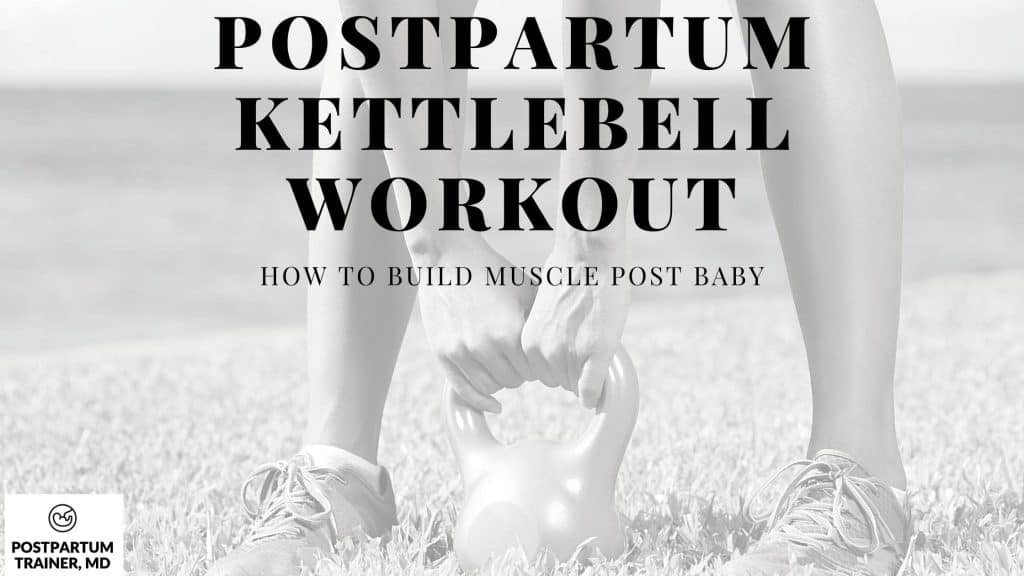Are you looking for a postpartum kettlebell workout?
Specifically, one that will help you build muscle, gain strength, and improve your cardio after baby?
Look no further.
In this post, you will learn why kettlebell training is so effective, especially after pregnancy.
So if you are ready to get in shape postpartum, let’s dive right in.

Kettlebell Workout Pre-Requisites
Before doing this workout (or any type of resistance workout), I want you to do a few things.
First, it is important that you wait until you are at least 6 weeks postpartum.
During those 6 weeks, you can work on a few things.
- You can strengthen your pelvic floor: The pelvic floor includes the muscles that prevent pelvic organ prolapse and urinary incontinence from happening. I go over the pelvic floor exercises here.
- The second thing you can do is basic bodyweight exercises such as bodyweight squats, and wall push-ups. These exercises are low impact and will help build strength, stability, and confidence.
- The third thing you can do is walk as much as you can. This will serve as cardio and help fulfill your daily movement.
- Lastly, you can consider taking some time to strengthen your core. This is especially true if you have abdominal separation known as diastasis recti. I have an entire post on how to tell if you have diastasis recti, and what to do about it. Furthermore, there are specific exercises you should avoid if you developed diastasis recti after a c-section.
Okay, if you check off all these boxes, let’s get to the workout.
The Postnatal Kettlebell Workout
Now let’s get to the actual workout. This is the kettlebell I use which can be purchased from amazon.
The workout is composed of 6 different exercises. Each kettlebell exercise is a compound exercise. This means that each movement will train multiple muscle groups at the same time.
This workout will last 20 minutes.
The goal is to accomplish as many rounds of each exercise as possible in the 20 minute time frame also known as an AMRAP (short for as many rounds as possible).
This does not mean you should rush through the exercises. Instead, I actually want you to take your time.
That way, we can make sure that you are using proper form.
Once you finish the prescribed repetitions of the first exercise, you will then rest for 30 seconds.
You will then perform the second exercise, rest for 30 seconds before doing the third exercise, and so on.
You will continue this sequence as many times as you can until the 20 minute timer runs out.
Ok, on to the exercises.
The Kettlebell exercises
Clean To Single Arm Shoulder Press
The clean to single arm shoulder press is the first kettlebell exercise in this workout.

This movement is great for improving the strength and stability of your shoulder and tricep muscles. It is also great for activating your core as you have to balance the weight overhead with just one arm.
Here is how the exercise looks:
- Grab the kettlebell and hold it in front of your thighs.
- Next, use some momentum to drive the kettlebell up toward your shoulder.
- Then, press the kettlebell up directly over your head by locking out your elbows.
- Slowly lower the kettlebell and return it back to your shoulder.
- From here, lower the kettlebell back down toward the ground and repeat.
Goblet Squat Press Outs
The next exercise is the goblet squat press out.

This exercise will strengthen your legs, your core and your shoulders. It will also improve your mobility and stability in the bottom of a squat.
Here’s how to do it:
- Grab the kettlebell in a goblet position (up close to your chest holding both sides of the kettlebell handle).
- Next, set your stance slightly wider than shoulder-width apart with your toes pointing out slightly.
- From here begin squatting down by bending at the hips and knees simultaneously.
- As you are descending push your hips back as if you were sitting on a chair that is slightly behind you.
- Once you reach the bottom of the squat position, pause for a second.
- Press the kettlebell straight out in front of your chest until your arms are locked out.
- Bring the kettlebell back to your chest and stand back up.
Single Legged Kettlebell Deadlifts
The next movement is the kettlebell deadlift. This exercise is great for developing the muscles of your glutes, hamstrings, and lower back.

You can do this exercise with two kettlebells (one in each hand) or with one (holding it on the opposite side of the working leg).
Here’s how the exercise looks:
- Hold the kettlebell in the hand opposite of the leg you are working at first.
- From here, brace your core and begin stepping the non-working leg back behind you.
- At the same time begin bending at the waist (not the spine) to lower the kettlebell toward the ground right by your foot.
- Make sure that your back is flat the entire time.
- Once the kettlebell touches the floor, reverse the movement and bring your feet back together.
- Finish all the repetitions on one side before moving on to the next side.
Split Stance Kettlebell Rows
The fourth exercise is the split stance kettlebell row. This movement will strengthen your upper back, your posterior shoulders, and improve your core strength and stability.

Here’s how to do it:
- Assume a split stance at a width where you feel most comfortable.
- Begin leaning forward until your chest is parallel to the floor, and your back is completely flat
- From here grab the kettlebell and hold it in your outstretched hand.
- Begin rowing the kettlebell up toward your rib cage by driving your elbow up toward the ceiling.
- Actively retract your shoulder blade to ensure you are working the proper muscles.
- Pause at your rib cage and slowly lower the weight back down.
- Finish all the repetitions on one side before switching legs and rowing with your other arm.
Surrender Squats
The last exercise is the surrender squat. This movement is great for strengthening all the muscles in your legs and activating your entire core.

Here’s how to do it:
- Place a cushion or a rolled up mat on the floor for you to kneel on.
- Place both knees on the cushion and assume a tall kneeling position.
- Next, grab the kettlebell and hold it up by your chest in the goblet position.
- From here, you are going to then pick one knee up off the ground and place that foot flat on the ground in front of you.
- From here, stand all the way up while maintaining the kettlebell up by your chest.
- Slowly lower back down into a tall kneeling position.
- Alternate between which leg initiates the movement.
The Workout
Here are the prescribed repetitions and rest periods for the postpartum kettlebell workout.
| Exercise | Repetitions |
|---|---|
| Kettlebell Clean and Press | 5 repetitions each arm |
| Rest 30 seconds | |
| Goblet Squat Press Outs | 5 repetitions |
| Rest 30 seconds | |
| Single Legged Kettlebell Deadlifts | 5 repetitions each side |
| Rest 30 seconds | |
| Split Stance Kettlebell Rows | 5 repetitions each arm |
| Rest 30 seconds | |
| Surrender Squats | 5 repetitions each side |
| Rest for 30 seconds |
Repeat…
Do as many rounds as you can in 20 minutes.
You can do this workout twice per week, in conjunction with other workouts listed here:
Related Questions
How long does it take to see results from kettlebells?
You can see result from kettlebell training in as little as 30 days. It depends on how often you are exercising and how hard you are exercising.
The good thing about kettlebell exercises is that they tend to be compound exercises. This means that they train multiple muscle groups at once. This is in contrast to isolation exercises that train just one muscle group at a time.
A good example is bicep curls.
Using compound exercises is the best way to get results as quickly as possible.
Can you lose weight with just kettlebells?
Yes, kettlebells can help you lose weight if you use them regularly and you improve your nutrition. Losing fat requires a multi-angle approach.
I go over more details in The Postpartum Trainer’s Nutrition Guide and How To Get Rid of Baby Fat Postpartum.
Is 20 minutes of kettlebells enough?
It depends on how intense your workout out. The postpartum trainer’s kettlebell workout is sufficiently intense to give you a proper workout in just 20 minutes a day.
If the workout is not challenging enough for you, there are three things you can do.
- You can increase the repetitions for each exercise to 6, or even 8 reps
- You can decrease the rest period to just 15 seconds
- You can increase the weight of the kettlebell you are using
There are so many ways to increase the intensity and get a great workout in 20 minutes.
Can kettlebells replace cardio?
Kettlebells can replace cardio if you use them in a way that sustains an elevation in your heart rate. The major advantage kettlebells have over traditional cardio is that they can help you build muscle, gain strength, and lose fat at the same time.
Regular cardio won’t help you build muscle or strength.
If you would like to learn more – check out these 3 postpartum high intensity interval training (HIIT) workouts.
How heavy should the kettlebell be?
It depends on your strength level. If you are a beginner, you can start with 12-15 lb kettlebells. As you get stronger and more experienced, you can use 25-35 lb kettlebells.
Are kettlebell swings safe for diastasic recti?
Kettlebell swings can be considered advanced exercise that require good core stability and total body mobility. While they aren’t contraindicated with diastasic recti, I suggest you stick to diastasis recti friendly exercises when starting out.
Here are 100 different exercises you can do that are DR safe.
Final Words On The Postnatal kettlebell workout
Kettlebell training is a great way to strengthen your core, your upper body and your lower body in the postpartum period.
As with any type of exercise, just make sure to get clearance from your doctor first, and pay attention to your technique.
I can’t wait for you to see the amazing results you are capable of achieving!
I want to hear from you.
Have you tried kettlebell training before or after pregnancy? What did you think?
Comment below and let me know!
Related Posts On Exercising Postpartum
- The Postpartum Squat Challenge [How Far Can You Go?]
- Postpartum Weightlifting [How and When To Start]
- Getting Fit After Pregnancy: [A Step By Step Guide]
Get Four Free Workouts To Help Strengthen Your Pelvic Floor & Heal Your Mommy Tummy!

Brittany Robles, MD, MPH, CPT
Brittany Robles is a full-time OBGYN physician, a NASM certified trainer, and a prenatal and postnatal fitness specialist. She holds a Master of Public Health degree in maternal health with a special interest in exercise and nutrition. She is also the co-author of The White Coat Trainer. Learn more about her here.
Sharing is Caring – Send This To A Mom In Need!
